Drama Industry of Pakistan is glorifying submissive women
VerifiedAdded on 2021/06/08
|11
|3022
|164
AI Summary
Contribute Materials
Your contribution can guide someone’s learning journey. Share your
documents today.
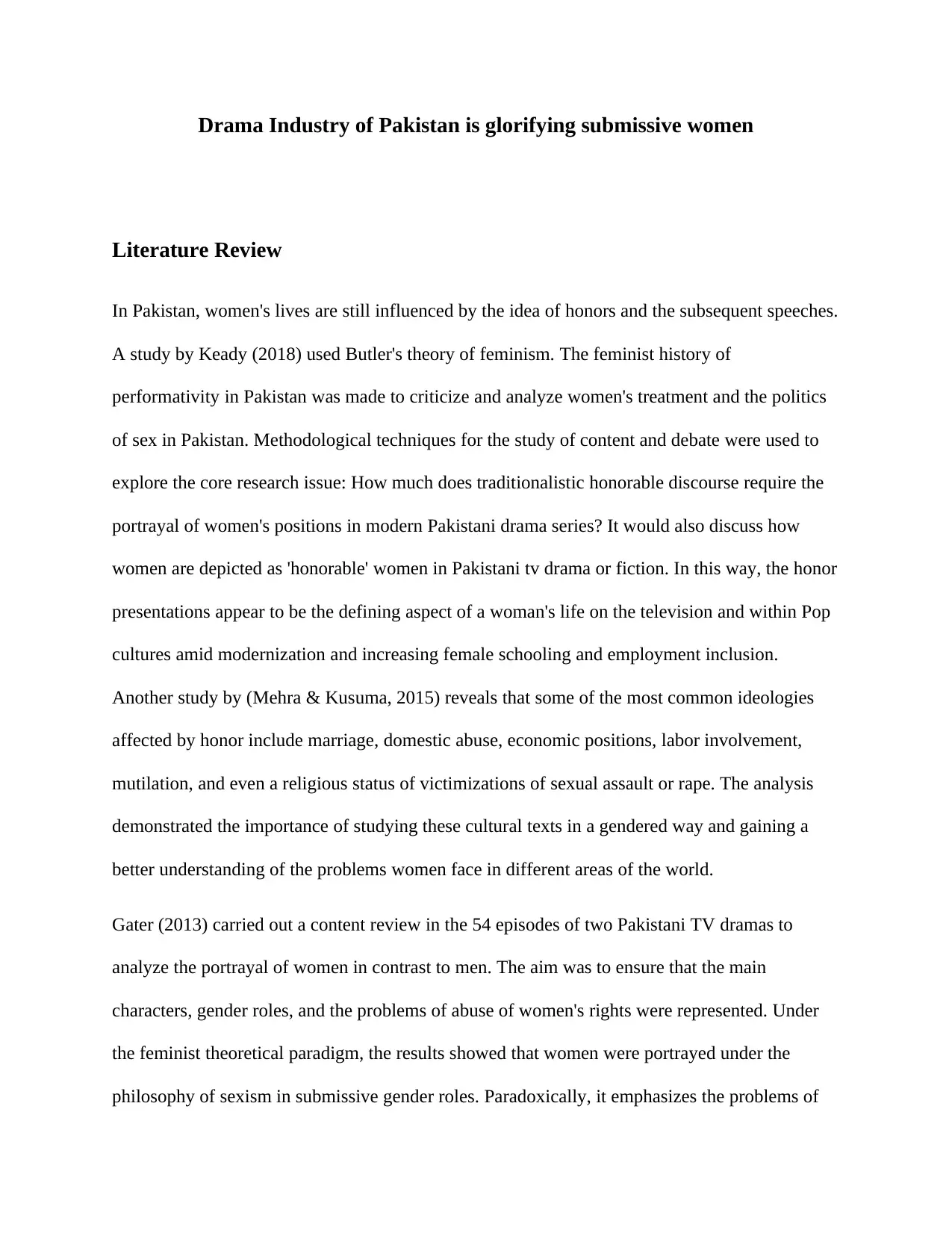
Drama Industry of Pakistan is glorifying submissive women
Literature Review
In Pakistan, women's lives are still influenced by the idea of honors and the subsequent speeches.
A study by Keady (2018) used Butler's theory of feminism. The feminist history of
performativity in Pakistan was made to criticize and analyze women's treatment and the politics
of sex in Pakistan. Methodological techniques for the study of content and debate were used to
explore the core research issue: How much does traditionalistic honorable discourse require the
portrayal of women's positions in modern Pakistani drama series? It would also discuss how
women are depicted as 'honorable' women in Pakistani tv drama or fiction. In this way, the honor
presentations appear to be the defining aspect of a woman's life on the television and within Pop
cultures amid modernization and increasing female schooling and employment inclusion.
Another study by (Mehra & Kusuma, 2015) reveals that some of the most common ideologies
affected by honor include marriage, domestic abuse, economic positions, labor involvement,
mutilation, and even a religious status of victimizations of sexual assault or rape. The analysis
demonstrated the importance of studying these cultural texts in a gendered way and gaining a
better understanding of the problems women face in different areas of the world.
Gater (2013) carried out a content review in the 54 episodes of two Pakistani TV dramas to
analyze the portrayal of women in contrast to men. The aim was to ensure that the main
characters, gender roles, and the problems of abuse of women's rights were represented. Under
the feminist theoretical paradigm, the results showed that women were portrayed under the
philosophy of sexism in submissive gender roles. Paradoxically, it emphasizes the problems of
Literature Review
In Pakistan, women's lives are still influenced by the idea of honors and the subsequent speeches.
A study by Keady (2018) used Butler's theory of feminism. The feminist history of
performativity in Pakistan was made to criticize and analyze women's treatment and the politics
of sex in Pakistan. Methodological techniques for the study of content and debate were used to
explore the core research issue: How much does traditionalistic honorable discourse require the
portrayal of women's positions in modern Pakistani drama series? It would also discuss how
women are depicted as 'honorable' women in Pakistani tv drama or fiction. In this way, the honor
presentations appear to be the defining aspect of a woman's life on the television and within Pop
cultures amid modernization and increasing female schooling and employment inclusion.
Another study by (Mehra & Kusuma, 2015) reveals that some of the most common ideologies
affected by honor include marriage, domestic abuse, economic positions, labor involvement,
mutilation, and even a religious status of victimizations of sexual assault or rape. The analysis
demonstrated the importance of studying these cultural texts in a gendered way and gaining a
better understanding of the problems women face in different areas of the world.
Gater (2013) carried out a content review in the 54 episodes of two Pakistani TV dramas to
analyze the portrayal of women in contrast to men. The aim was to ensure that the main
characters, gender roles, and the problems of abuse of women's rights were represented. Under
the feminist theoretical paradigm, the results showed that women were portrayed under the
philosophy of sexism in submissive gender roles. Paradoxically, it emphasizes the problems of
Secure Best Marks with AI Grader
Need help grading? Try our AI Grader for instant feedback on your assignments.
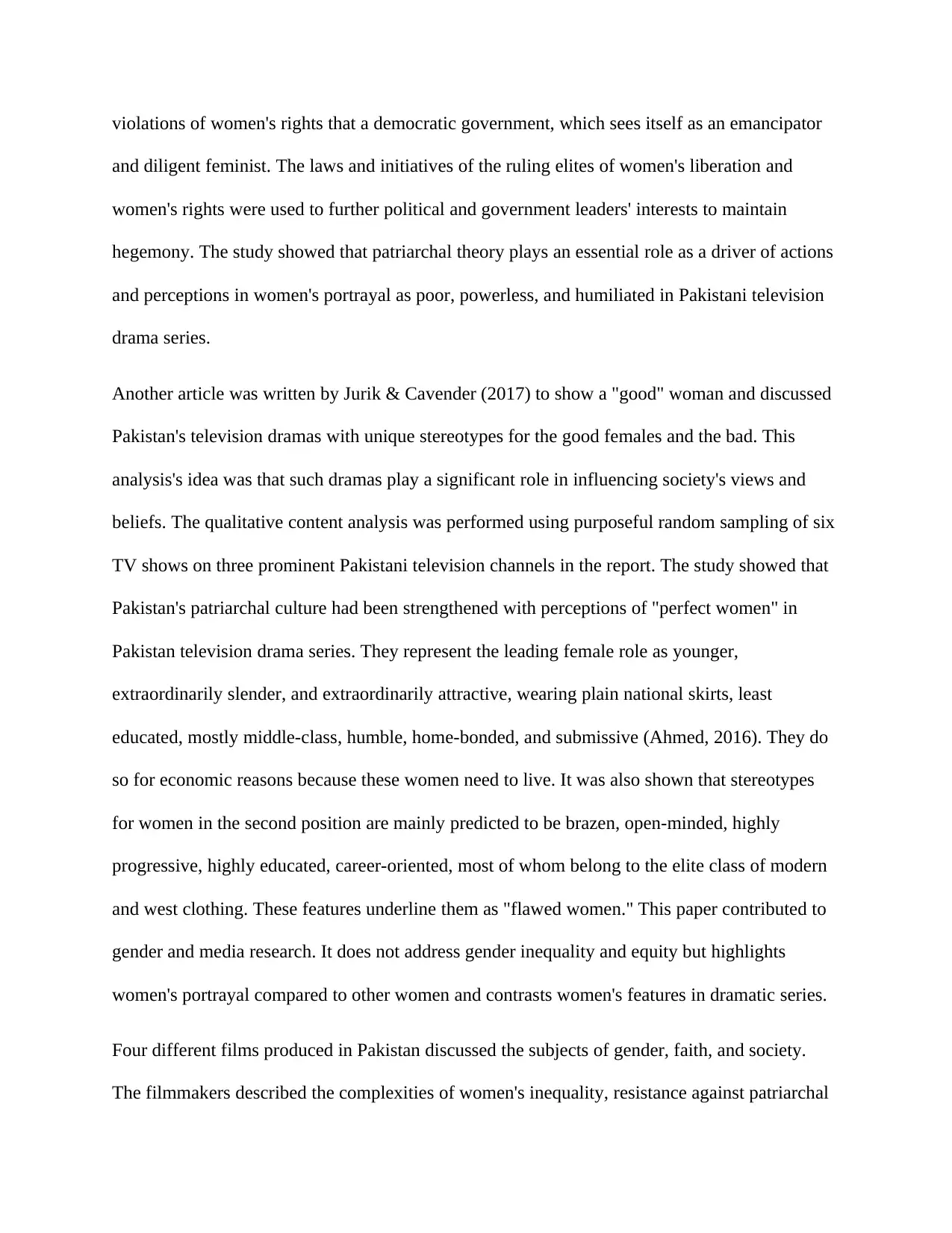
violations of women's rights that a democratic government, which sees itself as an emancipator
and diligent feminist. The laws and initiatives of the ruling elites of women's liberation and
women's rights were used to further political and government leaders' interests to maintain
hegemony. The study showed that patriarchal theory plays an essential role as a driver of actions
and perceptions in women's portrayal as poor, powerless, and humiliated in Pakistani television
drama series.
Another article was written by Jurik & Cavender (2017) to show a "good" woman and discussed
Pakistan's television dramas with unique stereotypes for the good females and the bad. This
analysis's idea was that such dramas play a significant role in influencing society's views and
beliefs. The qualitative content analysis was performed using purposeful random sampling of six
TV shows on three prominent Pakistani television channels in the report. The study showed that
Pakistan's patriarchal culture had been strengthened with perceptions of "perfect women" in
Pakistan television drama series. They represent the leading female role as younger,
extraordinarily slender, and extraordinarily attractive, wearing plain national skirts, least
educated, mostly middle-class, humble, home-bonded, and submissive (Ahmed, 2016). They do
so for economic reasons because these women need to live. It was also shown that stereotypes
for women in the second position are mainly predicted to be brazen, open-minded, highly
progressive, highly educated, career-oriented, most of whom belong to the elite class of modern
and west clothing. These features underline them as "flawed women." This paper contributed to
gender and media research. It does not address gender inequality and equity but highlights
women's portrayal compared to other women and contrasts women's features in dramatic series.
Four different films produced in Pakistan discussed the subjects of gender, faith, and society.
The filmmakers described the complexities of women's inequality, resistance against patriarchal
and diligent feminist. The laws and initiatives of the ruling elites of women's liberation and
women's rights were used to further political and government leaders' interests to maintain
hegemony. The study showed that patriarchal theory plays an essential role as a driver of actions
and perceptions in women's portrayal as poor, powerless, and humiliated in Pakistani television
drama series.
Another article was written by Jurik & Cavender (2017) to show a "good" woman and discussed
Pakistan's television dramas with unique stereotypes for the good females and the bad. This
analysis's idea was that such dramas play a significant role in influencing society's views and
beliefs. The qualitative content analysis was performed using purposeful random sampling of six
TV shows on three prominent Pakistani television channels in the report. The study showed that
Pakistan's patriarchal culture had been strengthened with perceptions of "perfect women" in
Pakistan television drama series. They represent the leading female role as younger,
extraordinarily slender, and extraordinarily attractive, wearing plain national skirts, least
educated, mostly middle-class, humble, home-bonded, and submissive (Ahmed, 2016). They do
so for economic reasons because these women need to live. It was also shown that stereotypes
for women in the second position are mainly predicted to be brazen, open-minded, highly
progressive, highly educated, career-oriented, most of whom belong to the elite class of modern
and west clothing. These features underline them as "flawed women." This paper contributed to
gender and media research. It does not address gender inequality and equity but highlights
women's portrayal compared to other women and contrasts women's features in dramatic series.
Four different films produced in Pakistan discussed the subjects of gender, faith, and society.
The filmmakers described the complexities of women's inequality, resistance against patriarchal
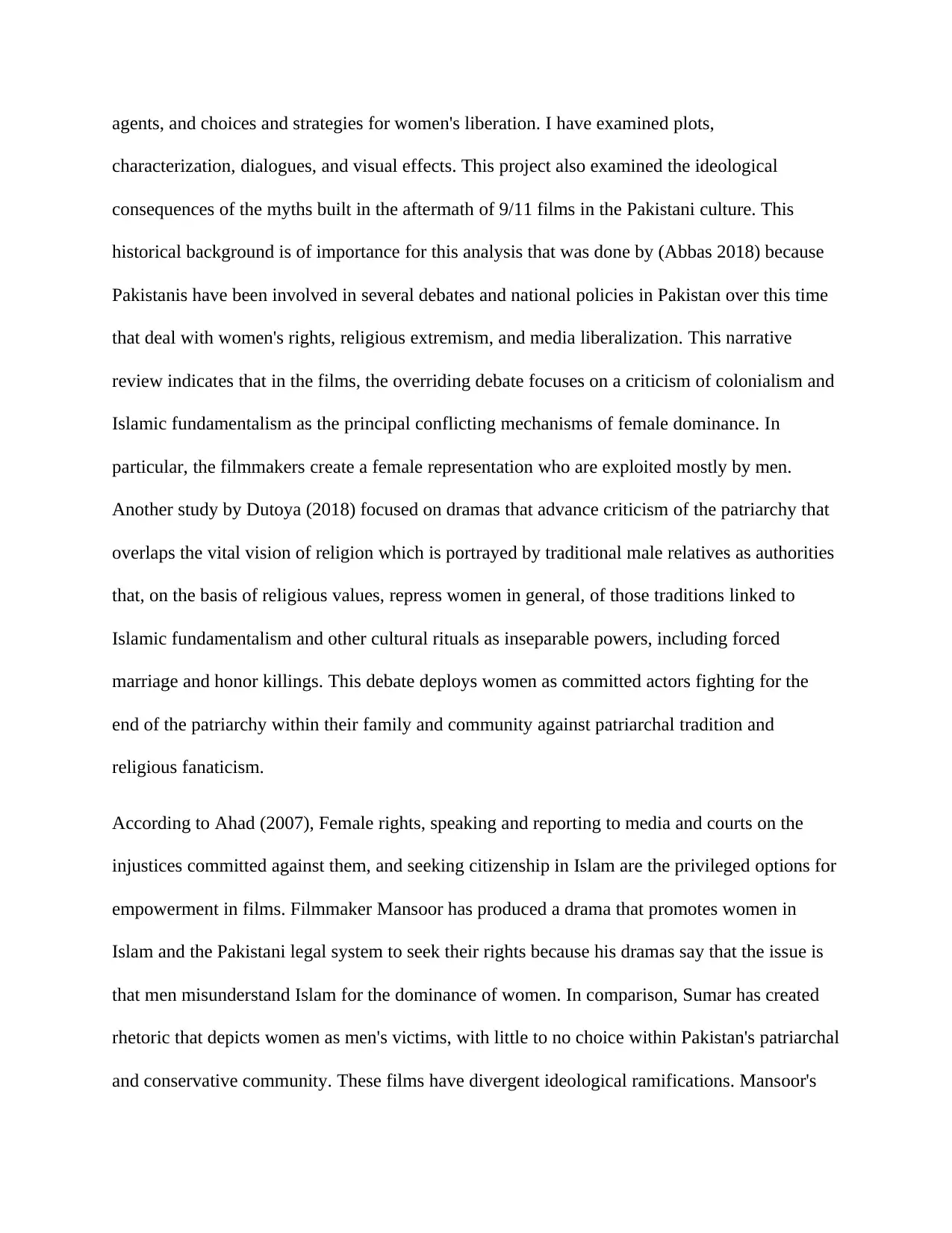
agents, and choices and strategies for women's liberation. I have examined plots,
characterization, dialogues, and visual effects. This project also examined the ideological
consequences of the myths built in the aftermath of 9/11 films in the Pakistani culture. This
historical background is of importance for this analysis that was done by (Abbas 2018) because
Pakistanis have been involved in several debates and national policies in Pakistan over this time
that deal with women's rights, religious extremism, and media liberalization. This narrative
review indicates that in the films, the overriding debate focuses on a criticism of colonialism and
Islamic fundamentalism as the principal conflicting mechanisms of female dominance. In
particular, the filmmakers create a female representation who are exploited mostly by men.
Another study by Dutoya (2018) focused on dramas that advance criticism of the patriarchy that
overlaps the vital vision of religion which is portrayed by traditional male relatives as authorities
that, on the basis of religious values, repress women in general, of those traditions linked to
Islamic fundamentalism and other cultural rituals as inseparable powers, including forced
marriage and honor killings. This debate deploys women as committed actors fighting for the
end of the patriarchy within their family and community against patriarchal tradition and
religious fanaticism.
According to Ahad (2007), Female rights, speaking and reporting to media and courts on the
injustices committed against them, and seeking citizenship in Islam are the privileged options for
empowerment in films. Filmmaker Mansoor has produced a drama that promotes women in
Islam and the Pakistani legal system to seek their rights because his dramas say that the issue is
that men misunderstand Islam for the dominance of women. In comparison, Sumar has created
rhetoric that depicts women as men's victims, with little to no choice within Pakistan's patriarchal
and conservative community. These films have divergent ideological ramifications. Mansoor's
characterization, dialogues, and visual effects. This project also examined the ideological
consequences of the myths built in the aftermath of 9/11 films in the Pakistani culture. This
historical background is of importance for this analysis that was done by (Abbas 2018) because
Pakistanis have been involved in several debates and national policies in Pakistan over this time
that deal with women's rights, religious extremism, and media liberalization. This narrative
review indicates that in the films, the overriding debate focuses on a criticism of colonialism and
Islamic fundamentalism as the principal conflicting mechanisms of female dominance. In
particular, the filmmakers create a female representation who are exploited mostly by men.
Another study by Dutoya (2018) focused on dramas that advance criticism of the patriarchy that
overlaps the vital vision of religion which is portrayed by traditional male relatives as authorities
that, on the basis of religious values, repress women in general, of those traditions linked to
Islamic fundamentalism and other cultural rituals as inseparable powers, including forced
marriage and honor killings. This debate deploys women as committed actors fighting for the
end of the patriarchy within their family and community against patriarchal tradition and
religious fanaticism.
According to Ahad (2007), Female rights, speaking and reporting to media and courts on the
injustices committed against them, and seeking citizenship in Islam are the privileged options for
empowerment in films. Filmmaker Mansoor has produced a drama that promotes women in
Islam and the Pakistani legal system to seek their rights because his dramas say that the issue is
that men misunderstand Islam for the dominance of women. In comparison, Sumar has created
rhetoric that depicts women as men's victims, with little to no choice within Pakistan's patriarchal
and conservative community. These films have divergent ideological ramifications. Mansoor's
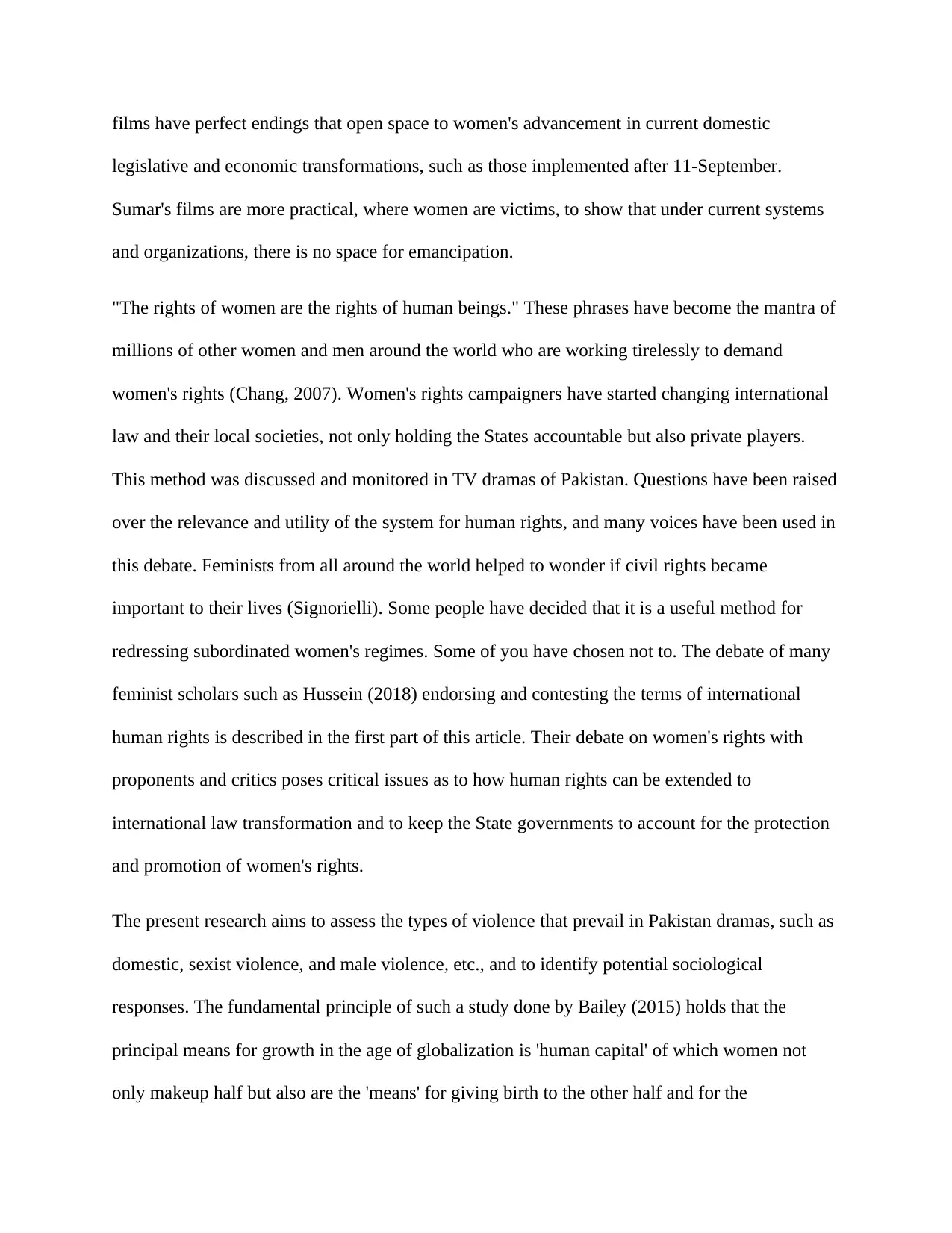
films have perfect endings that open space to women's advancement in current domestic
legislative and economic transformations, such as those implemented after 11-September.
Sumar's films are more practical, where women are victims, to show that under current systems
and organizations, there is no space for emancipation.
"The rights of women are the rights of human beings." These phrases have become the mantra of
millions of other women and men around the world who are working tirelessly to demand
women's rights (Chang, 2007). Women's rights campaigners have started changing international
law and their local societies, not only holding the States accountable but also private players.
This method was discussed and monitored in TV dramas of Pakistan. Questions have been raised
over the relevance and utility of the system for human rights, and many voices have been used in
this debate. Feminists from all around the world helped to wonder if civil rights became
important to their lives (Signorielli). Some people have decided that it is a useful method for
redressing subordinated women's regimes. Some of you have chosen not to. The debate of many
feminist scholars such as Hussein (2018) endorsing and contesting the terms of international
human rights is described in the first part of this article. Their debate on women's rights with
proponents and critics poses critical issues as to how human rights can be extended to
international law transformation and to keep the State governments to account for the protection
and promotion of women's rights.
The present research aims to assess the types of violence that prevail in Pakistan dramas, such as
domestic, sexist violence, and male violence, etc., and to identify potential sociological
responses. The fundamental principle of such a study done by Bailey (2015) holds that the
principal means for growth in the age of globalization is 'human capital' of which women not
only makeup half but also are the 'means' for giving birth to the other half and for the
legislative and economic transformations, such as those implemented after 11-September.
Sumar's films are more practical, where women are victims, to show that under current systems
and organizations, there is no space for emancipation.
"The rights of women are the rights of human beings." These phrases have become the mantra of
millions of other women and men around the world who are working tirelessly to demand
women's rights (Chang, 2007). Women's rights campaigners have started changing international
law and their local societies, not only holding the States accountable but also private players.
This method was discussed and monitored in TV dramas of Pakistan. Questions have been raised
over the relevance and utility of the system for human rights, and many voices have been used in
this debate. Feminists from all around the world helped to wonder if civil rights became
important to their lives (Signorielli). Some people have decided that it is a useful method for
redressing subordinated women's regimes. Some of you have chosen not to. The debate of many
feminist scholars such as Hussein (2018) endorsing and contesting the terms of international
human rights is described in the first part of this article. Their debate on women's rights with
proponents and critics poses critical issues as to how human rights can be extended to
international law transformation and to keep the State governments to account for the protection
and promotion of women's rights.
The present research aims to assess the types of violence that prevail in Pakistan dramas, such as
domestic, sexist violence, and male violence, etc., and to identify potential sociological
responses. The fundamental principle of such a study done by Bailey (2015) holds that the
principal means for growth in the age of globalization is 'human capital' of which women not
only makeup half but also are the 'means' for giving birth to the other half and for the
Secure Best Marks with AI Grader
Need help grading? Try our AI Grader for instant feedback on your assignments.
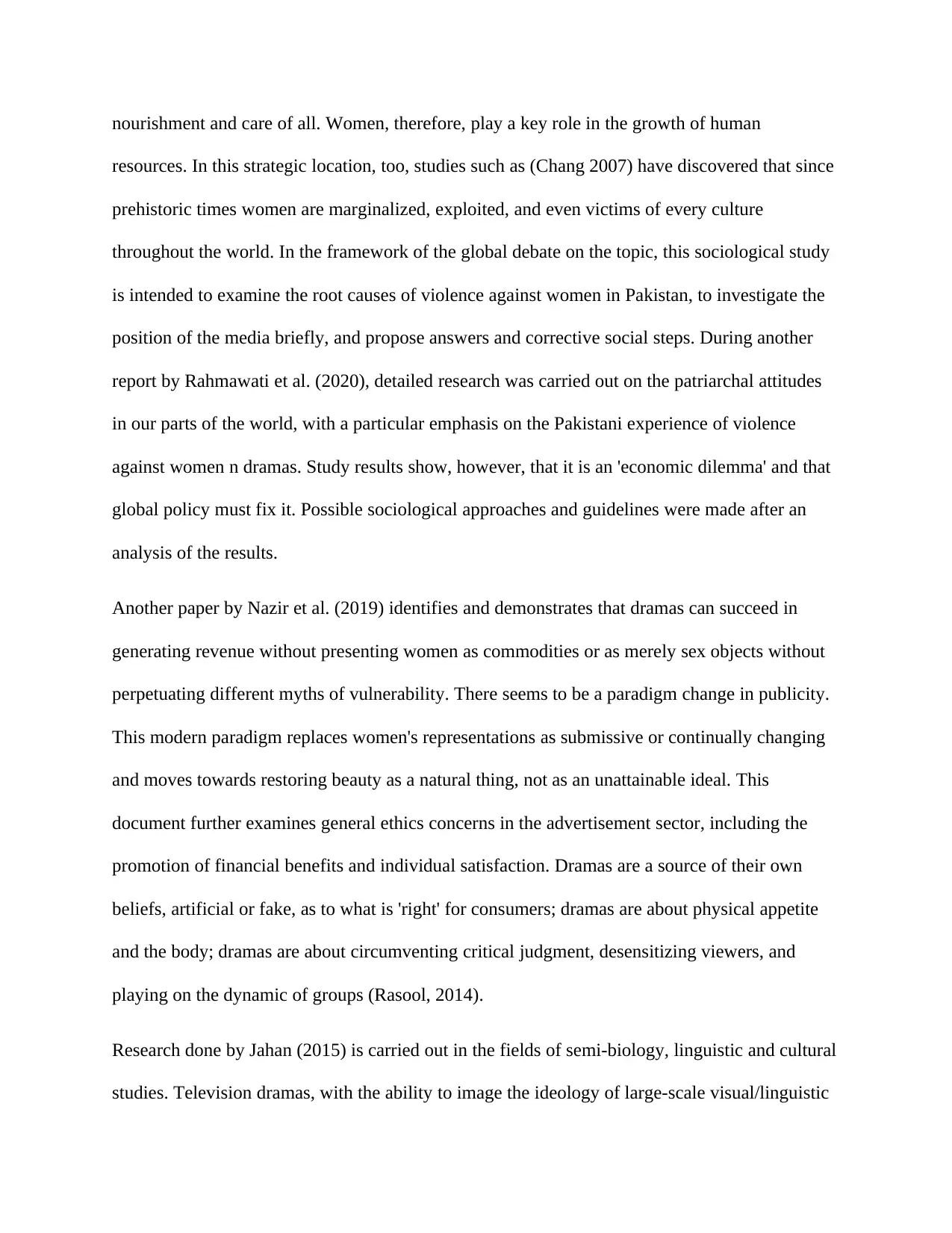
nourishment and care of all. Women, therefore, play a key role in the growth of human
resources. In this strategic location, too, studies such as (Chang 2007) have discovered that since
prehistoric times women are marginalized, exploited, and even victims of every culture
throughout the world. In the framework of the global debate on the topic, this sociological study
is intended to examine the root causes of violence against women in Pakistan, to investigate the
position of the media briefly, and propose answers and corrective social steps. During another
report by Rahmawati et al. (2020), detailed research was carried out on the patriarchal attitudes
in our parts of the world, with a particular emphasis on the Pakistani experience of violence
against women n dramas. Study results show, however, that it is an 'economic dilemma' and that
global policy must fix it. Possible sociological approaches and guidelines were made after an
analysis of the results.
Another paper by Nazir et al. (2019) identifies and demonstrates that dramas can succeed in
generating revenue without presenting women as commodities or as merely sex objects without
perpetuating different myths of vulnerability. There seems to be a paradigm change in publicity.
This modern paradigm replaces women's representations as submissive or continually changing
and moves towards restoring beauty as a natural thing, not as an unattainable ideal. This
document further examines general ethics concerns in the advertisement sector, including the
promotion of financial benefits and individual satisfaction. Dramas are a source of their own
beliefs, artificial or fake, as to what is 'right' for consumers; dramas are about physical appetite
and the body; dramas are about circumventing critical judgment, desensitizing viewers, and
playing on the dynamic of groups (Rasool, 2014).
Research done by Jahan (2015) is carried out in the fields of semi-biology, linguistic and cultural
studies. Television dramas, with the ability to image the ideology of large-scale visual/linguistic
resources. In this strategic location, too, studies such as (Chang 2007) have discovered that since
prehistoric times women are marginalized, exploited, and even victims of every culture
throughout the world. In the framework of the global debate on the topic, this sociological study
is intended to examine the root causes of violence against women in Pakistan, to investigate the
position of the media briefly, and propose answers and corrective social steps. During another
report by Rahmawati et al. (2020), detailed research was carried out on the patriarchal attitudes
in our parts of the world, with a particular emphasis on the Pakistani experience of violence
against women n dramas. Study results show, however, that it is an 'economic dilemma' and that
global policy must fix it. Possible sociological approaches and guidelines were made after an
analysis of the results.
Another paper by Nazir et al. (2019) identifies and demonstrates that dramas can succeed in
generating revenue without presenting women as commodities or as merely sex objects without
perpetuating different myths of vulnerability. There seems to be a paradigm change in publicity.
This modern paradigm replaces women's representations as submissive or continually changing
and moves towards restoring beauty as a natural thing, not as an unattainable ideal. This
document further examines general ethics concerns in the advertisement sector, including the
promotion of financial benefits and individual satisfaction. Dramas are a source of their own
beliefs, artificial or fake, as to what is 'right' for consumers; dramas are about physical appetite
and the body; dramas are about circumventing critical judgment, desensitizing viewers, and
playing on the dynamic of groups (Rasool, 2014).
Research done by Jahan (2015) is carried out in the fields of semi-biology, linguistic and cultural
studies. Television dramas, with the ability to image the ideology of large-scale visual/linguistic
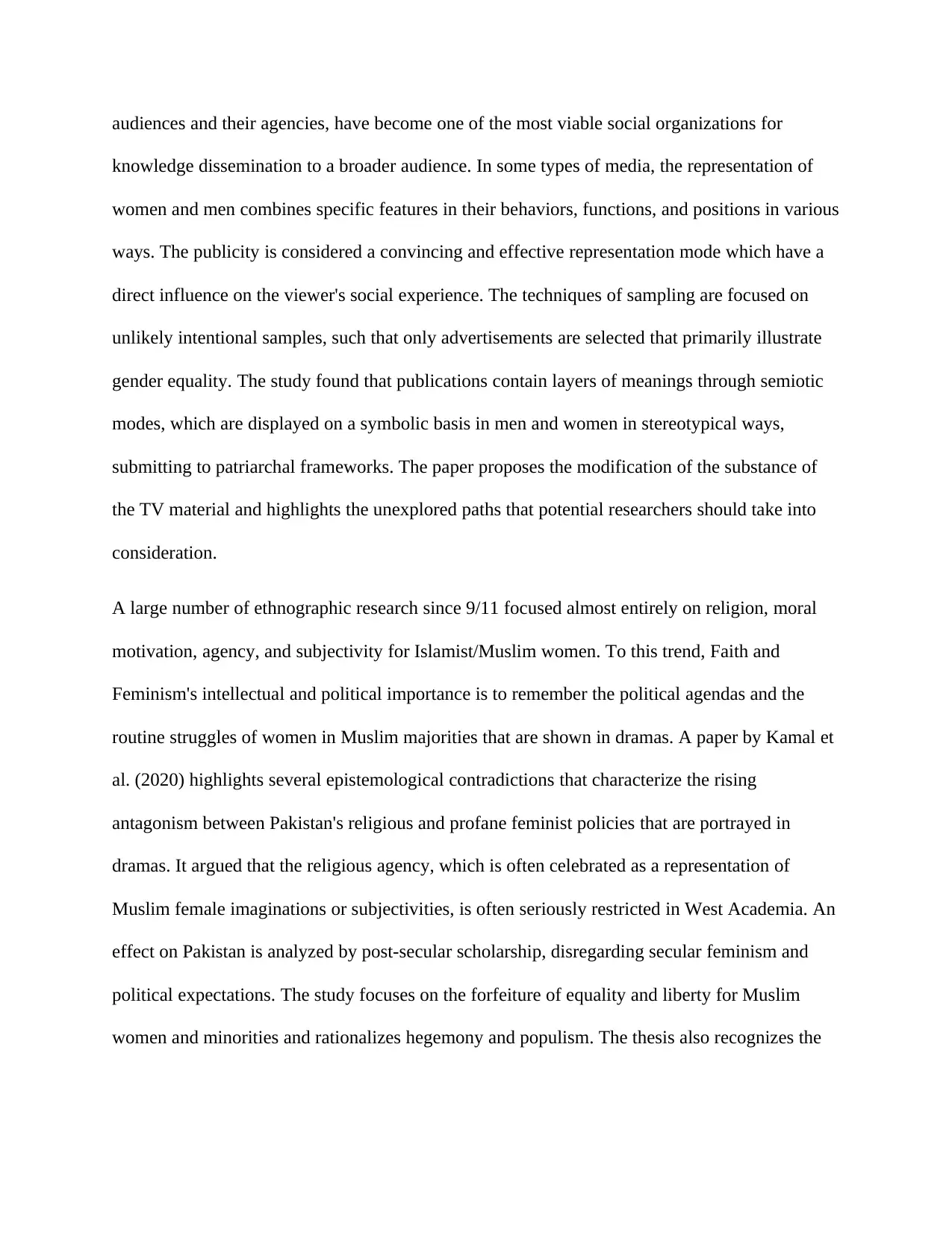
audiences and their agencies, have become one of the most viable social organizations for
knowledge dissemination to a broader audience. In some types of media, the representation of
women and men combines specific features in their behaviors, functions, and positions in various
ways. The publicity is considered a convincing and effective representation mode which have a
direct influence on the viewer's social experience. The techniques of sampling are focused on
unlikely intentional samples, such that only advertisements are selected that primarily illustrate
gender equality. The study found that publications contain layers of meanings through semiotic
modes, which are displayed on a symbolic basis in men and women in stereotypical ways,
submitting to patriarchal frameworks. The paper proposes the modification of the substance of
the TV material and highlights the unexplored paths that potential researchers should take into
consideration.
A large number of ethnographic research since 9/11 focused almost entirely on religion, moral
motivation, agency, and subjectivity for Islamist/Muslim women. To this trend, Faith and
Feminism's intellectual and political importance is to remember the political agendas and the
routine struggles of women in Muslim majorities that are shown in dramas. A paper by Kamal et
al. (2020) highlights several epistemological contradictions that characterize the rising
antagonism between Pakistan's religious and profane feminist policies that are portrayed in
dramas. It argued that the religious agency, which is often celebrated as a representation of
Muslim female imaginations or subjectivities, is often seriously restricted in West Academia. An
effect on Pakistan is analyzed by post-secular scholarship, disregarding secular feminism and
political expectations. The study focuses on the forfeiture of equality and liberty for Muslim
women and minorities and rationalizes hegemony and populism. The thesis also recognizes the
knowledge dissemination to a broader audience. In some types of media, the representation of
women and men combines specific features in their behaviors, functions, and positions in various
ways. The publicity is considered a convincing and effective representation mode which have a
direct influence on the viewer's social experience. The techniques of sampling are focused on
unlikely intentional samples, such that only advertisements are selected that primarily illustrate
gender equality. The study found that publications contain layers of meanings through semiotic
modes, which are displayed on a symbolic basis in men and women in stereotypical ways,
submitting to patriarchal frameworks. The paper proposes the modification of the substance of
the TV material and highlights the unexplored paths that potential researchers should take into
consideration.
A large number of ethnographic research since 9/11 focused almost entirely on religion, moral
motivation, agency, and subjectivity for Islamist/Muslim women. To this trend, Faith and
Feminism's intellectual and political importance is to remember the political agendas and the
routine struggles of women in Muslim majorities that are shown in dramas. A paper by Kamal et
al. (2020) highlights several epistemological contradictions that characterize the rising
antagonism between Pakistan's religious and profane feminist policies that are portrayed in
dramas. It argued that the religious agency, which is often celebrated as a representation of
Muslim female imaginations or subjectivities, is often seriously restricted in West Academia. An
effect on Pakistan is analyzed by post-secular scholarship, disregarding secular feminism and
political expectations. The study focuses on the forfeiture of equality and liberty for Muslim
women and minorities and rationalizes hegemony and populism. The thesis also recognizes the
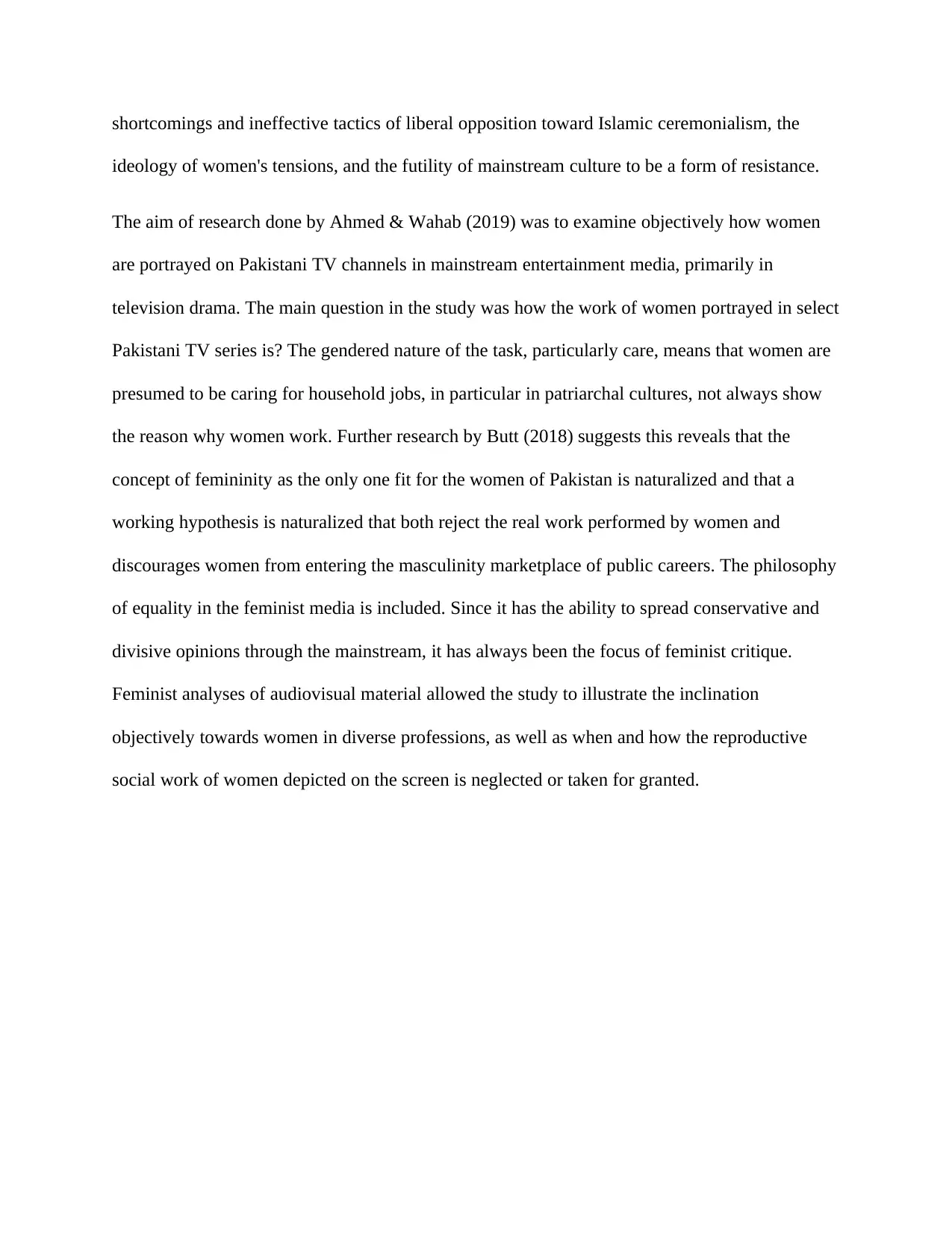
shortcomings and ineffective tactics of liberal opposition toward Islamic ceremonialism, the
ideology of women's tensions, and the futility of mainstream culture to be a form of resistance.
The aim of research done by Ahmed & Wahab (2019) was to examine objectively how women
are portrayed on Pakistani TV channels in mainstream entertainment media, primarily in
television drama. The main question in the study was how the work of women portrayed in select
Pakistani TV series is? The gendered nature of the task, particularly care, means that women are
presumed to be caring for household jobs, in particular in patriarchal cultures, not always show
the reason why women work. Further research by Butt (2018) suggests this reveals that the
concept of femininity as the only one fit for the women of Pakistan is naturalized and that a
working hypothesis is naturalized that both reject the real work performed by women and
discourages women from entering the masculinity marketplace of public careers. The philosophy
of equality in the feminist media is included. Since it has the ability to spread conservative and
divisive opinions through the mainstream, it has always been the focus of feminist critique.
Feminist analyses of audiovisual material allowed the study to illustrate the inclination
objectively towards women in diverse professions, as well as when and how the reproductive
social work of women depicted on the screen is neglected or taken for granted.
ideology of women's tensions, and the futility of mainstream culture to be a form of resistance.
The aim of research done by Ahmed & Wahab (2019) was to examine objectively how women
are portrayed on Pakistani TV channels in mainstream entertainment media, primarily in
television drama. The main question in the study was how the work of women portrayed in select
Pakistani TV series is? The gendered nature of the task, particularly care, means that women are
presumed to be caring for household jobs, in particular in patriarchal cultures, not always show
the reason why women work. Further research by Butt (2018) suggests this reveals that the
concept of femininity as the only one fit for the women of Pakistan is naturalized and that a
working hypothesis is naturalized that both reject the real work performed by women and
discourages women from entering the masculinity marketplace of public careers. The philosophy
of equality in the feminist media is included. Since it has the ability to spread conservative and
divisive opinions through the mainstream, it has always been the focus of feminist critique.
Feminist analyses of audiovisual material allowed the study to illustrate the inclination
objectively towards women in diverse professions, as well as when and how the reproductive
social work of women depicted on the screen is neglected or taken for granted.
Paraphrase This Document
Need a fresh take? Get an instant paraphrase of this document with our AI Paraphraser
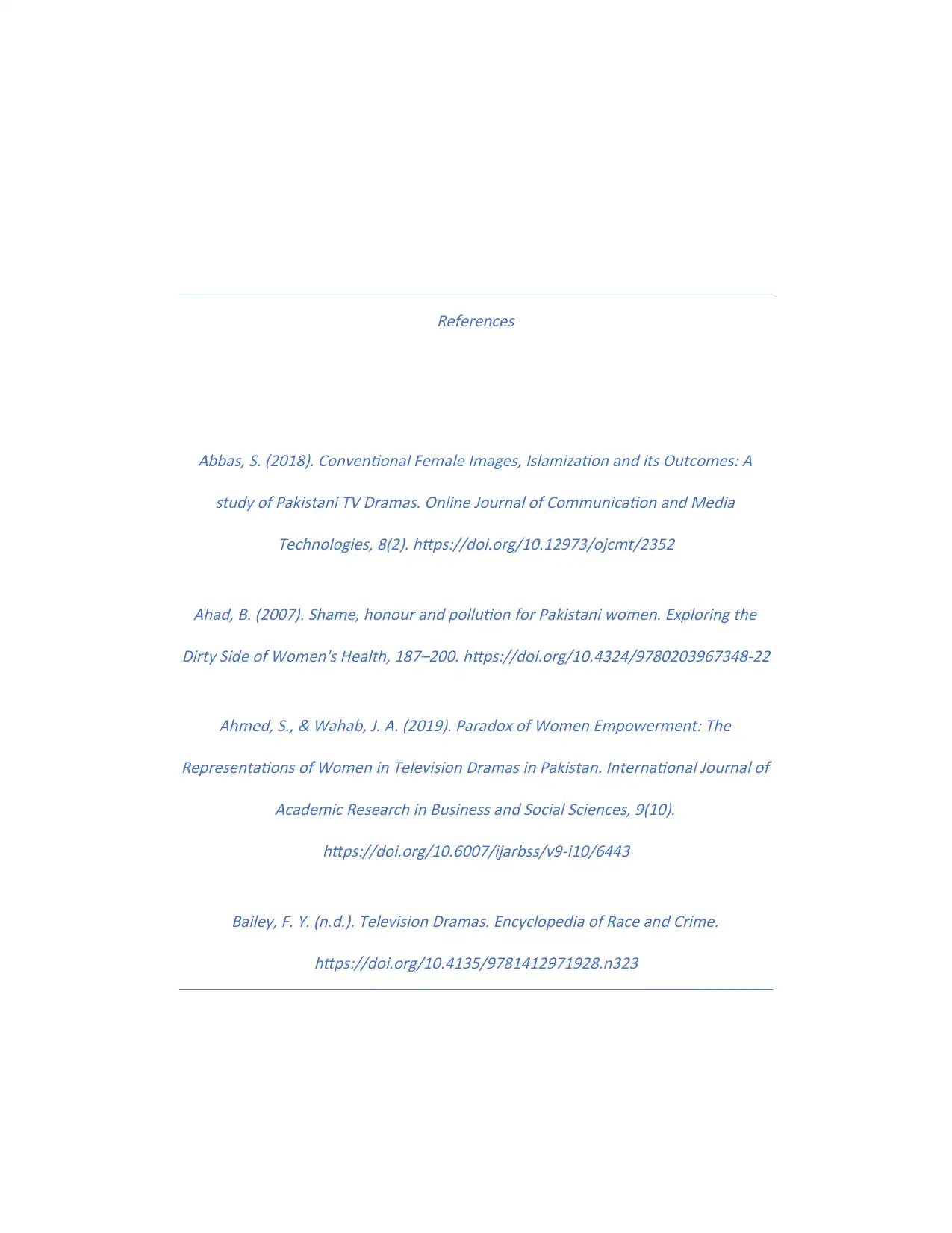
References
Abbas, S. (2018). Conventional Female Images, Islamization and its Outcomes: A
study of Pakistani TV Dramas. Online Journal of Communication and Media
Technologies, 8(2). https://doi.org/10.12973/ojcmt/2352
Ahad, B. (2007). Shame, honour and pollution for Pakistani women. Exploring the
Dirty Side of Women's Health, 187–200. https://doi.org/10.4324/9780203967348-22
Ahmed, S., & Wahab, J. A. (2019). Paradox of Women Empowerment: The
Representations of Women in Television Dramas in Pakistan. International Journal of
Academic Research in Business and Social Sciences, 9(10).
https://doi.org/10.6007/ijarbss/v9-i10/6443
Bailey, F. Y. (n.d.). Television Dramas. Encyclopedia of Race and Crime.
https://doi.org/10.4135/9781412971928.n323
Abbas, S. (2018). Conventional Female Images, Islamization and its Outcomes: A
study of Pakistani TV Dramas. Online Journal of Communication and Media
Technologies, 8(2). https://doi.org/10.12973/ojcmt/2352
Ahad, B. (2007). Shame, honour and pollution for Pakistani women. Exploring the
Dirty Side of Women's Health, 187–200. https://doi.org/10.4324/9780203967348-22
Ahmed, S., & Wahab, J. A. (2019). Paradox of Women Empowerment: The
Representations of Women in Television Dramas in Pakistan. International Journal of
Academic Research in Business and Social Sciences, 9(10).
https://doi.org/10.6007/ijarbss/v9-i10/6443
Bailey, F. Y. (n.d.). Television Dramas. Encyclopedia of Race and Crime.
https://doi.org/10.4135/9781412971928.n323
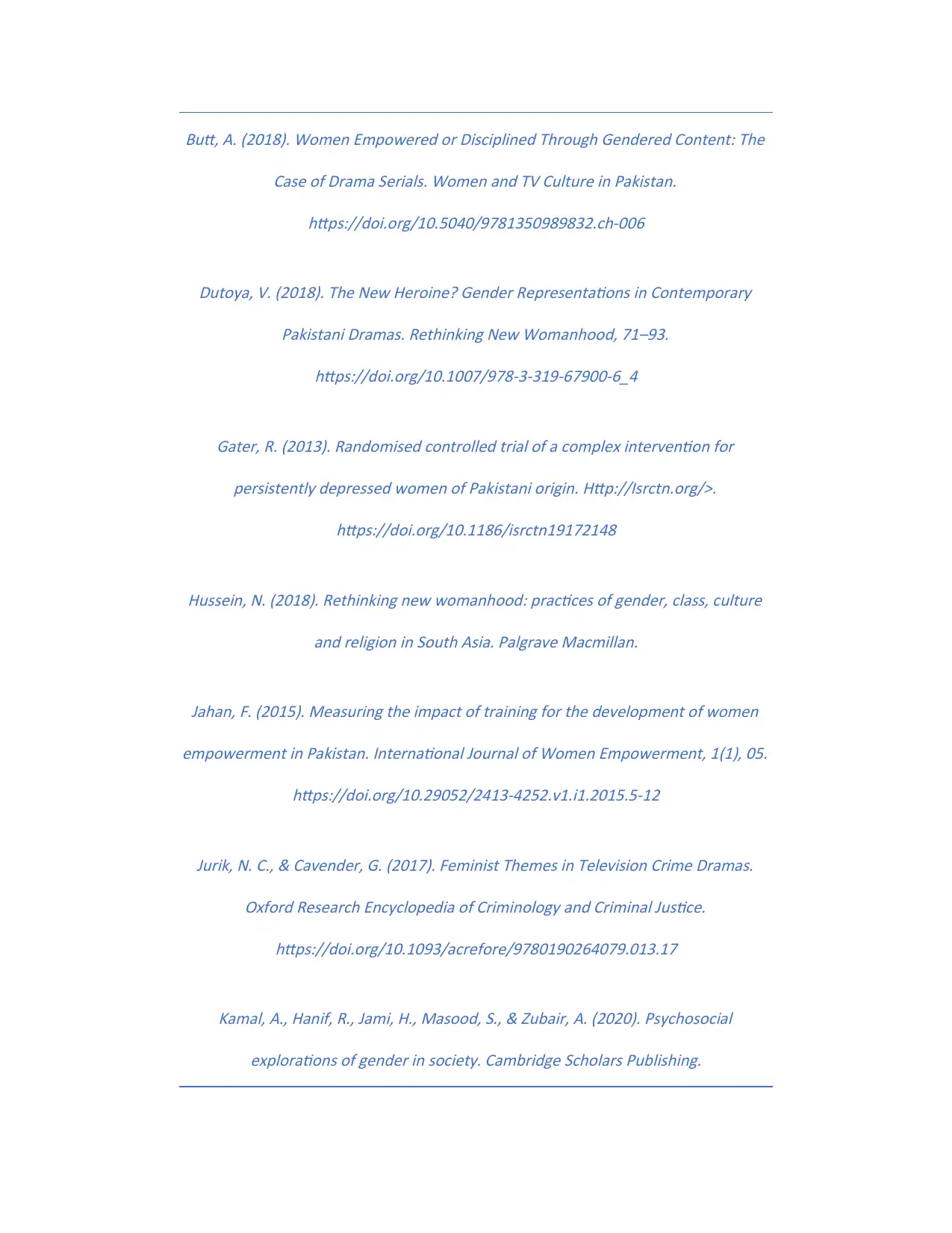
Butt, A. (2018). Women Empowered or Disciplined Through Gendered Content: The
Case of Drama Serials. Women and TV Culture in Pakistan.
https://doi.org/10.5040/9781350989832.ch-006
Dutoya, V. (2018). The New Heroine? Gender Representations in Contemporary
Pakistani Dramas. Rethinking New Womanhood, 71–93.
https://doi.org/10.1007/978-3-319-67900-6_4
Gater, R. (2013). Randomised controlled trial of a complex intervention for
persistently depressed women of Pakistani origin. Http://Isrctn.org/>.
https://doi.org/10.1186/isrctn19172148
Hussein, N. (2018). Rethinking new womanhood: practices of gender, class, culture
and religion in South Asia. Palgrave Macmillan.
Jahan, F. (2015). Measuring the impact of training for the development of women
empowerment in Pakistan. International Journal of Women Empowerment, 1(1), 05.
https://doi.org/10.29052/2413-4252.v1.i1.2015.5-12
Jurik, N. C., & Cavender, G. (2017). Feminist Themes in Television Crime Dramas.
Oxford Research Encyclopedia of Criminology and Criminal Justice.
https://doi.org/10.1093/acrefore/9780190264079.013.17
Kamal, A., Hanif, R., Jami, H., Masood, S., & Zubair, A. (2020). Psychosocial
explorations of gender in society. Cambridge Scholars Publishing.
Case of Drama Serials. Women and TV Culture in Pakistan.
https://doi.org/10.5040/9781350989832.ch-006
Dutoya, V. (2018). The New Heroine? Gender Representations in Contemporary
Pakistani Dramas. Rethinking New Womanhood, 71–93.
https://doi.org/10.1007/978-3-319-67900-6_4
Gater, R. (2013). Randomised controlled trial of a complex intervention for
persistently depressed women of Pakistani origin. Http://Isrctn.org/>.
https://doi.org/10.1186/isrctn19172148
Hussein, N. (2018). Rethinking new womanhood: practices of gender, class, culture
and religion in South Asia. Palgrave Macmillan.
Jahan, F. (2015). Measuring the impact of training for the development of women
empowerment in Pakistan. International Journal of Women Empowerment, 1(1), 05.
https://doi.org/10.29052/2413-4252.v1.i1.2015.5-12
Jurik, N. C., & Cavender, G. (2017). Feminist Themes in Television Crime Dramas.
Oxford Research Encyclopedia of Criminology and Criminal Justice.
https://doi.org/10.1093/acrefore/9780190264079.013.17
Kamal, A., Hanif, R., Jami, H., Masood, S., & Zubair, A. (2020). Psychosocial
explorations of gender in society. Cambridge Scholars Publishing.
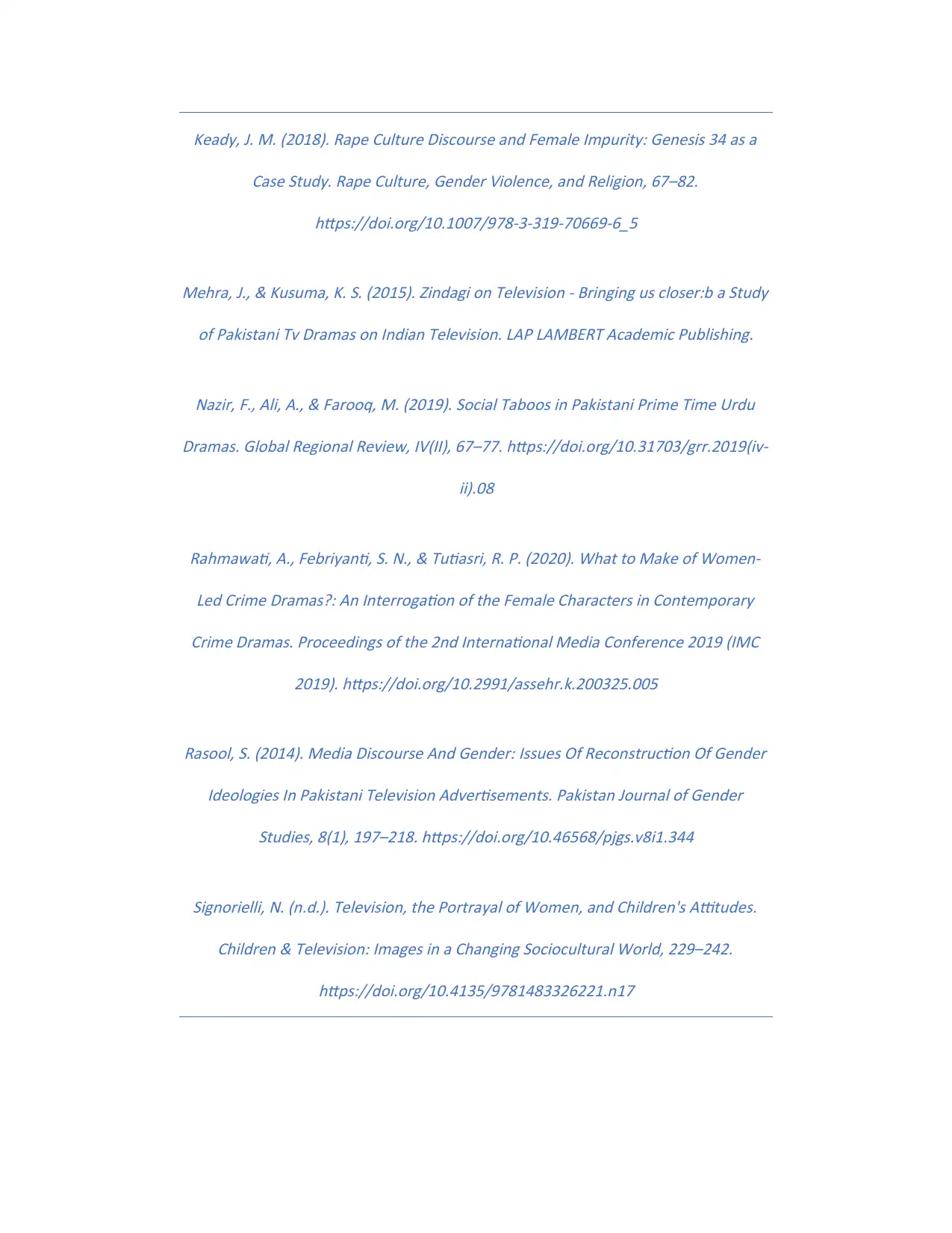
Keady, J. M. (2018). Rape Culture Discourse and Female Impurity: Genesis 34 as a
Case Study. Rape Culture, Gender Violence, and Religion, 67–82.
https://doi.org/10.1007/978-3-319-70669-6_5
Mehra, J., & Kusuma, K. S. (2015). Zindagi on Television - Bringing us closer:b a Study
of Pakistani Tv Dramas on Indian Television. LAP LAMBERT Academic Publishing.
Nazir, F., Ali, A., & Farooq, M. (2019). Social Taboos in Pakistani Prime Time Urdu
Dramas. Global Regional Review, IV(II), 67–77. https://doi.org/10.31703/grr.2019(iv-
ii).08
Rahmawati, A., Febriyanti, S. N., & Tutiasri, R. P. (2020). What to Make of Women-
Led Crime Dramas?: An Interrogation of the Female Characters in Contemporary
Crime Dramas. Proceedings of the 2nd International Media Conference 2019 (IMC
2019). https://doi.org/10.2991/assehr.k.200325.005
Rasool, S. (2014). Media Discourse And Gender: Issues Of Reconstruction Of Gender
Ideologies In Pakistani Television Advertisements. Pakistan Journal of Gender
Studies, 8(1), 197–218. https://doi.org/10.46568/pjgs.v8i1.344
Signorielli, N. (n.d.). Television, the Portrayal of Women, and Children's Attitudes.
Children & Television: Images in a Changing Sociocultural World, 229–242.
https://doi.org/10.4135/9781483326221.n17
Case Study. Rape Culture, Gender Violence, and Religion, 67–82.
https://doi.org/10.1007/978-3-319-70669-6_5
Mehra, J., & Kusuma, K. S. (2015). Zindagi on Television - Bringing us closer:b a Study
of Pakistani Tv Dramas on Indian Television. LAP LAMBERT Academic Publishing.
Nazir, F., Ali, A., & Farooq, M. (2019). Social Taboos in Pakistani Prime Time Urdu
Dramas. Global Regional Review, IV(II), 67–77. https://doi.org/10.31703/grr.2019(iv-
ii).08
Rahmawati, A., Febriyanti, S. N., & Tutiasri, R. P. (2020). What to Make of Women-
Led Crime Dramas?: An Interrogation of the Female Characters in Contemporary
Crime Dramas. Proceedings of the 2nd International Media Conference 2019 (IMC
2019). https://doi.org/10.2991/assehr.k.200325.005
Rasool, S. (2014). Media Discourse And Gender: Issues Of Reconstruction Of Gender
Ideologies In Pakistani Television Advertisements. Pakistan Journal of Gender
Studies, 8(1), 197–218. https://doi.org/10.46568/pjgs.v8i1.344
Signorielli, N. (n.d.). Television, the Portrayal of Women, and Children's Attitudes.
Children & Television: Images in a Changing Sociocultural World, 229–242.
https://doi.org/10.4135/9781483326221.n17
Secure Best Marks with AI Grader
Need help grading? Try our AI Grader for instant feedback on your assignments.
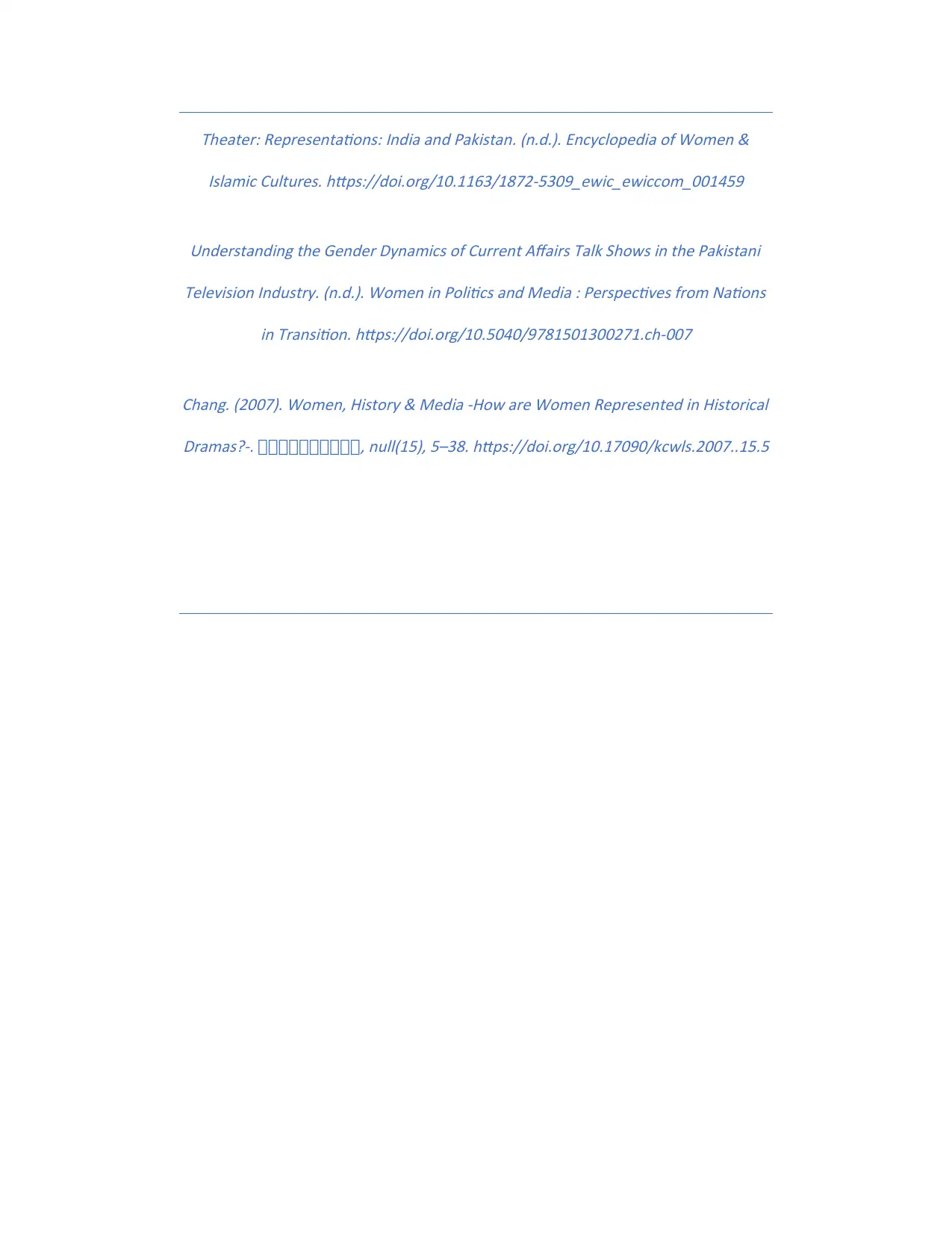
Theater: Representations: India and Pakistan. (n.d.). Encyclopedia of Women &
Islamic Cultures. https://doi.org/10.1163/1872-5309_ewic_ewiccom_001459
Understanding the Gender Dynamics of Current Affairs Talk Shows in the Pakistani
Television Industry. (n.d.). Women in Politics and Media : Perspectives from Nations
in Transition. https://doi.org/10.5040/9781501300271.ch-007
Chang. (2007). Women, History & Media -How are Women Represented in Historical
Dramas?-. 한한한한한한한한한한, null(15), 5–38. https://doi.org/10.17090/kcwls.2007..15.5
Islamic Cultures. https://doi.org/10.1163/1872-5309_ewic_ewiccom_001459
Understanding the Gender Dynamics of Current Affairs Talk Shows in the Pakistani
Television Industry. (n.d.). Women in Politics and Media : Perspectives from Nations
in Transition. https://doi.org/10.5040/9781501300271.ch-007
Chang. (2007). Women, History & Media -How are Women Represented in Historical
Dramas?-. 한한한한한한한한한한, null(15), 5–38. https://doi.org/10.17090/kcwls.2007..15.5
1 out of 11
Related Documents
Your All-in-One AI-Powered Toolkit for Academic Success.
+13062052269
info@desklib.com
Available 24*7 on WhatsApp / Email
![[object Object]](/_next/static/media/star-bottom.7253800d.svg)
Unlock your academic potential
© 2024 | Zucol Services PVT LTD | All rights reserved.




